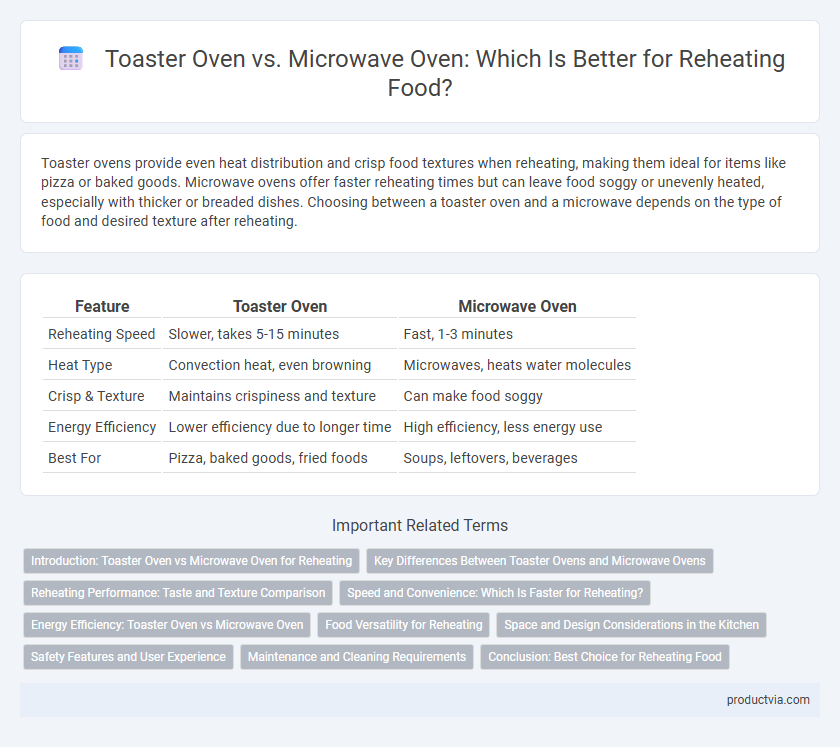Toaster ovens provide even heat distribution and crisp food textures when reheating, making them ideal for items like pizza or baked goods. Microwave ovens offer faster reheating times but can leave food soggy or unevenly heated, especially with thicker or breaded dishes. Choosing between a toaster oven and a microwave depends on the type of food and desired texture after reheating.
Table of Comparison
| Feature | Toaster Oven | Microwave Oven |
|---|---|---|
| Reheating Speed | Slower, takes 5-15 minutes | Fast, 1-3 minutes |
| Heat Type | Convection heat, even browning | Microwaves, heats water molecules |
| Crisp & Texture | Maintains crispiness and texture | Can make food soggy |
| Energy Efficiency | Lower efficiency due to longer time | High efficiency, less energy use |
| Best For | Pizza, baked goods, fried foods | Soups, leftovers, beverages |
Introduction: Toaster Oven vs Microwave Oven for Reheating
Toaster ovens provide more even reheating and crisping, preserving food texture better than microwave ovens, which often produce uneven heat and soggy results. Microwave ovens excel in speed and convenience, making them ideal for quick reheating of liquids and soft foods. Choosing between the two depends on whether texture or speed is the priority for reheating.
Key Differences Between Toaster Ovens and Microwave Ovens
Toaster ovens use radiant heat to reheat food, which results in a crispier texture, while microwave ovens rely on electromagnetic waves to quickly heat food from the inside out without browning. Toaster ovens typically take longer to reheat but provide even cooking and better flavor retention, making them ideal for baked goods and leftovers requiring crunch. Microwave ovens are more energy-efficient and faster, suitable for reheating soups, beverages, and soft foods without drying them out.
Reheating Performance: Taste and Texture Comparison
Toaster ovens deliver superior reheating performance by evenly distributing heat, preserving the original texture and taste of foods with a crispy finish, unlike microwave ovens which often cause sogginess or uneven warmth. The dry heat in toaster ovens prevents moisture buildup, making it ideal for reheating baked goods, pizza, and fried items, while microwaves excel in speed but sacrifice texture quality. For maintaining flavor integrity and a desirable texture, toaster ovens are the preferred choice for reheating meals.
Speed and Convenience: Which Is Faster for Reheating?
Toaster ovens typically take longer to reheat food compared to microwave ovens, which use electromagnetic waves to heat food quickly and evenly within minutes. Microwaves offer superior speed and convenience for reheating, especially for liquid or soft foods, while toaster ovens provide a crispy texture but require more time and monitoring. For fast reheating, microwave ovens remain the preferred choice due to their efficiency and ease of use.
Energy Efficiency: Toaster Oven vs Microwave Oven
Microwave ovens are generally more energy-efficient for reheating due to their ability to directly heat water molecules in food, reducing cooking time and energy use compared to toaster ovens. Toaster ovens consume more electricity because they rely on heating elements to warm the air inside, resulting in longer heating durations and higher energy consumption. For quick reheating tasks, microwaves often provide a more energy-saving solution than toaster ovens.
Food Versatility for Reheating
Toaster ovens offer greater food versatility for reheating by evenly crisping and warming a wide range of items such as pizza, pastries, and casseroles, preserving texture and flavor. Microwave ovens excel in speed but often result in uneven heating and soggy textures, especially with bread-based or fried foods. For diverse reheating needs that require both texture retention and consistent warmth, toaster ovens provide superior performance compared to microwave ovens.
Space and Design Considerations in the Kitchen
Toaster ovens typically have a compact design that fits easily on countertops, making them ideal for kitchens with limited space while offering versatile reheating options. Microwave ovens usually require more clearance for ventilation but are often more space-efficient vertically, suitable for built-in or over-the-range installations. Choosing between the two depends on the kitchen layout, countertop space, and desired integration with existing appliances.
Safety Features and User Experience
Toaster ovens provide even reheating with a crisp texture, featuring cool-touch handles and automatic shut-off timers for enhanced safety, reducing burn risks and energy waste. Microwave ovens excel in speed and convenience, equipped with child locks and sensor cooking to prevent overheating and ensure uniform heating. User experience varies as toaster ovens require slightly longer reheating times but deliver better food quality, while microwaves prioritize rapid reheating with simpler controls and compact designs.
Maintenance and Cleaning Requirements
Toaster ovens require regular cleaning of crumb trays and interior surfaces to prevent buildup and ensure optimal performance, while microwave ovens need frequent wiping of the interior to remove food splatters and odors. Toaster ovens may have removable racks and trays for easier maintenance, whereas microwave interiors are typically smooth and easier to clean with a damp cloth. Both appliances benefit from periodic deep cleaning, but microwave ovens generally demand less frequent and less intensive maintenance.
Conclusion: Best Choice for Reheating Food
A toaster oven provides even heat distribution, preserving food texture and preventing sogginess, making it ideal for reheating baked goods and crispy items. Microwave ovens reheat food quickly but often cause uneven heating and moisture loss, which can affect taste and texture negatively. For the best balance of speed and quality when reheating, a toaster oven is the superior choice.
Toaster oven vs Microwave oven for reheating Infographic

 productvia.com
productvia.com